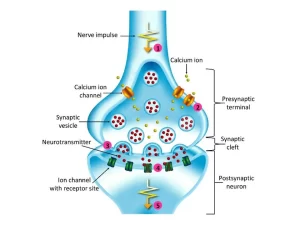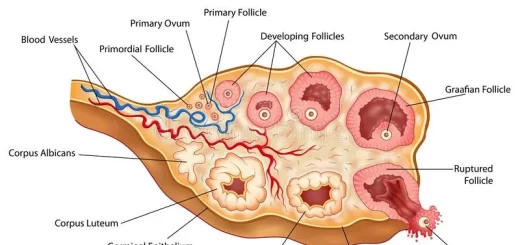Features of synaptic transmission, Mechanism of sensitization and long term potentiation
Synaptic transmission is the process by which one neuron communicates with another, The information is passed down the axon of the neuron as an electrical impulse known as an action potential, When the action potential reaches the end of the axon it needs to be transferred to another neuron or tissue, The synapse permits a neuron (or nerve cell) to pass an electrical or chemical signal to another neuron or to the target effector cell in the nervous system, Synapses are important to the transmission of nervous impulses from one neuron to another.
Characteristics of synaptic transmission
1. Forward conduction
At a synapse, impulses are conducted only in one direction from the presynaptic to the post-synaptic neuron and never in the reverse direction.
2. Summation
A single EPSP is not sufficient to stimulate the postsynaptic neuron. Therefore, the effects of several EPSP must add up or summate to increase the excitability of the postsynaptic neuron to the threshold level in order to trigger a propagated action potential. There are two types of summation:
- Temporal summation, it occurs by stimulation of a single presynaptic fiber repetitively, provided the interval between stimuli does not exceed 15 milliseconds, thus successive EPSPS can summate and raise the postsynaptic membrane potential to a threshold level.
- Spatial summation it occurs by stimulation of several presynaptic fibers that converge on the postsynaptic neuron at the same time, so that the produced EPSPS summate together and raise the postsynaptic membrane potential to the threshold level.
3. Synaptic delay
When an impulse reaches the presynaptic terminals, there is an interval of, at least, 0.5 millisecond before the response is obtained in the postsynaptic neuron. This time is needed for the release of the neurotransmitter, its diffusion across the synaptic cleft, its binding to the post-synaptic receptors, Na+ influx to produce the EPSP, and summation of the EPSPs to the threshold value.
4. Synaptic fatigue
Repetitive stimulation of the presynaptic fibers at a rapid rate, leads at first to maximal discharge from the postsynaptic neurons, but with elapse of time, such postsynaptic discharge gradually decreases. This is known as fatigue of synaptic transmission and it is due to exhaustion of the neurotransmitter stores in the synaptic knobs. Synaptic fatigue can serve as a protective mechanism for preventing excess neuronal activity e.g. cessation of an epileptic fit which would otherwise be fatal.
5. Synaptic plasticity
Synaptic plasticity is the ability of the synapse, between two neurons to change in strength in response to either use or disuse. i.e. synaptic conduction can be strengthened or weakened on the basis of past experience, These changes are of great interest because they represent forms of learning and memory; these changes could be in the form of:
1. Habituation
It is a decrease in response to a stimulus when that stimulus is presented repeatedly, Habituation is a form of negative memory.
Mechanism of habituation
There is a gradual decrease in the postsynaptic response with repeated presynaptic stimulation. It is due to less release of neurotransmitters from the presynaptic terminals as a result of reduction of the intracellular calcium.
2. Sensitization
It is an enhanced response to a stimulus after the presentation of another intense or noxious stimulus. For example, an animal responds more vigorously to a mild tactile stimulus after it has received a painful pinch.
Mechanism of sensitization
- Stimulation of a facilitatory presynaptic terminal at the same time that the sensory terminal is stimulated causes serotonin release at the facilitatory synapse on the surface of the sensory terminal. The released serotonin from the facilitatory neuron causes closure of potassium channels in the presynaptic ending which decreases potassium efflux.
- Lack of potassium conductance causes a greatly prolonged action potential in the synaptic terminal because the flow of potassium ions out of the terminal is necessary for rapid recovery from the action potential.
- The prolonged action potential causes the prolonged activation of the calcium channels, allowing tremendous quantities of calcium ions to enter the sensory synaptic terminal, These calcium ions cause greatly increased transmitter release by the synapse, thereby markedly facilitating the synaptic transmission to the subsequent neuron.
Thus, in a very indirect way, the associative effect of stimulating the facilitatory terminal, at the same time that the sensory terminal is stimulated causes a prolonged increase in the excitatory sensitivity of the sensory terminal, and this establishes the memory trace.
3. Long-term potentiation (LPT)
LTP is an enhancement of the postsynaptic potential response to presynaptic stimulation after a rapidly repeated stimulation of the presynaptic neuron for a brief period, It is initiated by an increase in intracellular Ca2+, Ca2+ in the postsynaptic rather than the presynaptic neuron, It occurs in many parts of the nervous system but has been studied in the greatest detail in the hippocampus where the excitatory neurotransmitter is glutamate.
Glutamate has 2 types of inotropic receptors:
- NMDA receptors which typically allow small amount of Ca2+ influx and are blocked by Mg2+.
- AMPA receptors which typically allow Na influx and depolarize the postsynaptic cell.
Mechanism of long-term potentiation
The events leading to long-term potentiation in the cells of the hippocampal formation can be summarized as follows:
- During induction of LTP, strong stimulation occurs at the synapse which opens a large number of AMPA receptors, generating an EPSP that is sufficient to trigger a postsynaptic action potential.
- The action potential generates a large depolarization that is able to expel Mg2+ from the pore of the NMDA receptor, permitting Ca2+ influx which in turn activates several signalling pathways.
- These signalling pathways allow the insertion of more AMPA receptors in the postsynaptic membrane to make the cell more sensitive to glutamate and send a signal to the presynaptic membrane asking the presynaptic cell to release more glutamate.
These changes enhance the response of the postsynaptic cell to glutamate and increase the amount of glutamate released from the presynaptic cell. Habituation and sensitization are examples of a form of memory called implicit memory, while long term potentiation represents another form of memory known as explicit memory:
1. Implicit (Non-declarative) memory
This type of memory is typically acquired without conscious effort for recall and guides behavior unconsciously.
Characteristics
Implicit memory is mainly automatic, it is slowly acquired, through repetition over many trials and practice. It is less likely to be forgotten e.g you don’t forget how to ride a bike or play tennis once learned.
Areas involved in the storage of implicit memory
Different forms of implicit memory are acquired through different forms of learning and involve different brain regions for storage. For example, memory acquired through fear, which has an emotional component, is thought to involve the amygdala. Memory acquired through learning motor skills involves the striatum and cerebellum. Memory acquired through sensitization, and habituation involves changes in the sensory and motor systems involved in learning.
2. Explicit (Declarative) memory
This type of memory involves conscious retrieval of previous experiences as well as conscious recall of facts. It can be further classified into:
- Episodic memory which is the memory of personal experiences or past events.
- Semantic memory which is the memory for facts, words, rules, and language.
Characteristics
This type of memory is highly flexible; multiple pieces of information can be linked and associated under different circumstances. It is easily acquired and can be forgotten.
Areas involved in the storage of explicit memory
There is no single long-term storage area for explicit memory. Long-term storage begins in the hippocampus which plays a role in converting short-term into long-term memory through the process of long-term potentiation, and over time explicit memories are transformed into various regions of the cortex. Working memory is one form of explicit memory of short duration.
Histological organization of spinal cord, Relation between spinal & vertebral segments
Synaptic transmission steps, Synapses types & Nature of the postsynaptic change
Histological structure of Cerebral cortex & Types of neurons in the cerebral cortex
Blood supply of CNS (central nervous system), Carotid system & Circle of Willis
Referred pain examples, Causes of neuropathic pain & Pain control mechanisms
Skull function, anatomy, structure, views & Criteria of neonatal skull




